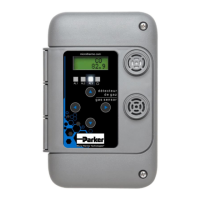023-064X Technical Manual
70-PHW-1018-R3.2 MTA 8.5 023-064X Refrigerant Leak Detector Manual.docx 5
2 Installation
Important. All wiring must conform to local building codes, regulations and laws. If the equipment is used in
a manner not specified by the manufacturer, the protection provided by the equipment may be impaired.
2.1 Sensor Placement
Coverage
Guidelines for sensor placement of diffusion type sensors are based on the reasonable delay for gas to
get from the source
to
the sensor. All sensors are created equal in this r
egar
d.
• For air quality control of exhaust emissions and accumulations of toxic gases the generally
acceptable
maximum radius of coverage is 50 feet (15 meters). Approximately 7500 square
feet (700 square meters).
•
For leak detection of combustible gases, ammonia, refrigeration gases the maximum radius is 30
feet (10
meters) since they can escape more quickly and the risk is greater.
The radius of coverage of any sensor does not extend
beyond
any obstruction that impedes natural
circulation of air. This includes walls, stairs, elevators, shelving with solid fill,
tool
chests, etc. The
sensor must “see” the area of coverage; if
not,
another
sensor(s)
is required.
Mounting Heights
Mounting heights for gas sensors are based on their density, relative to air. There are three
groups;
1. A gas lighter than air will be more concentrated near the ceiling; hydrogen, methane (natural
gas), ammonia, helium. Install at 1 to 3 feet from ceiling.
2. A gas similar density to air will be diluted in air equally at all levels; - carbon monoxide, nitrogen
dioxide, hydrogen sulfide, oxygen, carbon dioxide. Install from 3 feet
(1
meter)
off floor to one half
of the ceiling height. For vehicle emissions carbon monoxide detectors combined
with
nitrogen
dioxide detectors are installed at 3 to 5 feet (1 to 2 meters) from the floor when the ceiling is 7 to 10
feet high. If the ceiling height is higher than 10 feet, for example for heavy equipment, the carbon
monoxide detectors are installed at 3 to 5 feet (1 to 1.5 meters) from the floor as per the
requirements of the Canada building code and the nitrogen dioxide detectors should be installed at
50% of the ceiling height and above the vehicle height. If the exhaust pipes of diesel vehicles are
below the vehicles, then the nitrogen dioxide detectors should be installed at 3 to 5 feet (1 to 1.5
meters) from the floor. In all cases the
detectors
must be installed above obstructions blocking
circulation
of
air in front of the detectors; example, maintenance garages in automobile dealerships
where tool chests, work tables and storage racks typically line all walls.
3. A gas heavier than air will concentrate near the floor; - HFCs, HCFCs, propane, chlorine, most
organic vapors, butane. Install 1-3 feet (30cm to 1 meter) from floor.
For all types of sensors avoid drafts, obstacles, aerosols, silicones. Place sensors in the center of its
coverage area as much as possible.
2.2 Maintenance guide
Visual verification recommended frequency: once per week. The system incorporates monitoring software
which checks the operation of the circuits. This software is always running when the unit is powered on. Ensure
that the unit is installed on an independent circuit. It is recommended that the unit be checked once per week to
ensure that it is on, by the presence of reading on the display.
Verification of communication and calibration of sensors recommended frequency: once per year. It is
recommended that sensor be verified with standardized bottled gas mixtures by the manufacturer or other
qualified specialist or the sensor plug-in module be replaced with a new or factory calibrated module. The
communication between the sensor and control systems should be tested. A report of compliance should be
supplied and available on the site.

